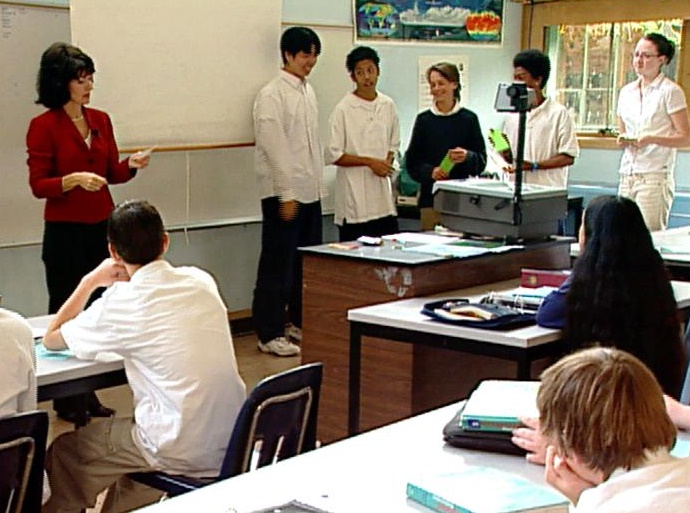The earnings and opportunities gap that separates high school dropouts and graduates is wide, and it’s widening all the time. Yet 40 percent of New Mexico’s public school students quit their formal education before earning a diploma that can improve their options over a lifetime.
Those dismal statistics motivated David Sidebottom, a branch manager of Century Bank, to introduce the Choices education program to Santa Fe schools six years ago. Using a curriculum designed by the nonprofit Choices Education Group, Sidebottom and other volunteers visit eighth-graders for two hour-long workshops that illustrate in tangible, age-appropriate terms the consequences of quitting school prematurely.
They don’t lecture, but rather engage the young teens in role-playing activities.
 In one, a student receives “play” money that represents his wages for a job that doesn’t require a high school diploma. Another classmate pretending to be a high school graduate gets more cash, while the best payout goes to the student playing the college graduate. After students surrender money for rent, food and other essentials, it’s obvious who has money left over for entertainment and recreation.
In one, a student receives “play” money that represents his wages for a job that doesn’t require a high school diploma. Another classmate pretending to be a high school graduate gets more cash, while the best payout goes to the student playing the college graduate. After students surrender money for rent, food and other essentials, it’s obvious who has money left over for entertainment and recreation.
Another scenario has students pretend to be job seekers while classmates play employment counselors trying to find them jobs that match their educational levels. Participants see that employers offer more — and better-paying — jobs to applicants with the highest educational achievement.
 It’s sobering stuff that resonates with eighth-graders, Sidebottom said, “because this is the age when the concept starts to set in — that they have four more years of school.”
It’s sobering stuff that resonates with eighth-graders, Sidebottom said, “because this is the age when the concept starts to set in — that they have four more years of school.”
Graduation and autonomy seem excruciatingly distant to 12- and 13-year-olds, and volunteers empathize. But they urge students while they’re still receptive to see the time as an opportunity to prepare for a fuller life. If they’re struggling, Sidebottom said, “they still have time to turn things around.”
One of several studies corroborating the effectiveness of CHOICES was a controlled teacher-administered study conducted in the 2008-2009 academic year in Helena, MT, that demonstrated that students who participated in CHOICES increased their engagement 47 percent more than those in the control group.
Sidebottom said the anecdotal evidence from teachers and counselors is also positive. His goal is 100 percent graduation rates, which is essential if Santa Feans and other New Mexicans hope to enjoy the opportunities and salaries available to workers with 21st century skills.
Statistics support his assertions: “Nearly every good job requires some certification, license, apprenticeship, (associate) degree, or other advanced credential,” the New Mexico Public Education Department emphasizes on its website. “High school dropouts face a 13 percent unemployment rate and earn an average (annual) income of $11,426,” according to the PED.
By comparison, “young adults with a bachelor’s degree earned (105 percent) more than those without a high school credential … and 57 percent more than young adult high school completers,” according to a report from the National Center for Education Statistics based on 2012 statistics.
Century Bank sponsors the program so it can be offered free to Santa Fe schools, and the Santa Fe Chamber of Commerce workforce development committee recruits volunteers. But Sidebottom needs other volunteers to help with the interventions. “Our students need help,” he said. “They need to hear about success, failure and how education can create more choices for their future. But they have to hear it from others in our community.”
To volunteer for Choices, contact Sidebottom at 505-995-1251 or by email at David.Sidebottom@centurybnk.com. For information about starting a Choices program in another city, visit www.choices.org.
Download 391_Business Volunteers Give Eighth-Graders Incentive to Graduate PDF

